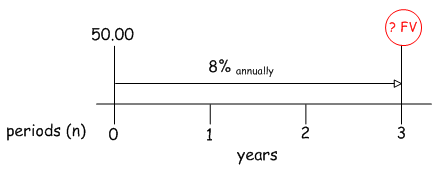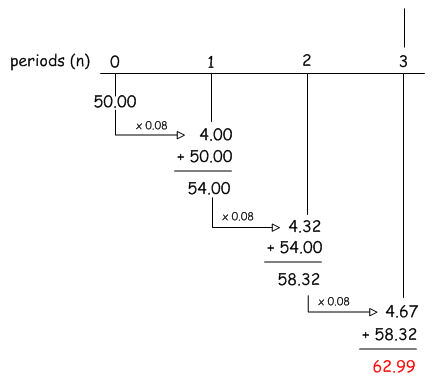Future Value of a Single Sum
1. Definition and Formula
The future value (FV) of a single sum tells us the amount to which a lump sum will grow to in the future given a particular interest rate and time period.
The future value is calculated as:

where:
PV = present value
FV = future value
i = interest rate
n = number of compounding periods
2. Example
How much will I receive at the end of 3 years (n) if I invest a single sum of $50 today (PV) at 8% (i) interest compounded annually? In other words, at 8%, how large will $50 grow in 3 years.
The problem statement provides values for three of the four variables in the equation: an investor will receive $100 (FV) in three years’ time (n) and this amount can be “discounted” back to today at 5% (i) in order to calculate the price of the CD (PV).


Thus, $86.38 invested today at 5% annual interest will grow to $100.00 in three years.
3. Concept
The mechanics of the discounting are illustrated here. Working backwards from $100 at 5% we see that this amount is worth only $95.24 if it were to be received in 1 year; $90.07 in 2 years; and $86,38 in 3 years.

In essence what “present value” means is that the receipt of $100 in three years’ time is worth the same as $86.38 today. The logic behind this assertion is that if we deposited $86.38 into an investment account paying 5% annually, it would grow to $100 in three years. In this case we should be indifferent as to our preference for receiving the money today or in three years because the two amounts can be considered financially equivalent.
Of course this is not entirely true. In reality there are a host of other factors to consider before we can declare “equivalence.” However, some of these factors (i.e., taxes, inflation, liquidity, credit risk, etc.) can be accounted for by choosing an appropriate interest (discount) rate.
While not precise, time value theory can still serve as a powerful tool for analyzing financial alternatives by providing a mechanism for placing cash flows at different time periods on a comparable basis.
